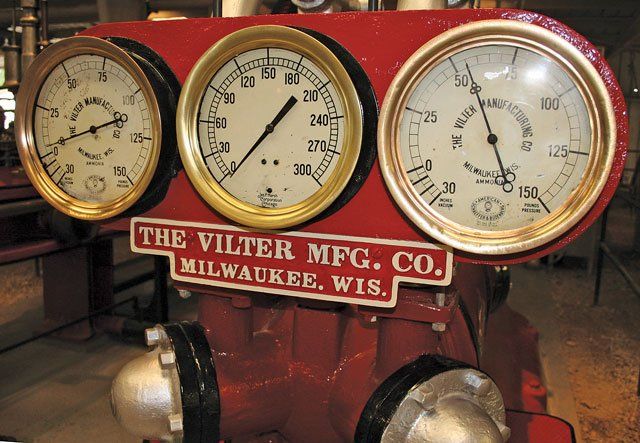Vilter: A Mirror of America's Past
Milwaukee
Wisconsin’s largest city, proudly sits on the western shore of Lake Michigan. With a population of over 600,000 and a rich cultural history, it has adopted many nicknames: Brew City, City of Steeples, Cream City and more, each reflecting an aspect of Milwaukee’s motley personalities. Milwaukee is known for it’s beer, midwestern-flavored urban culture, and its working-class history depicted by the classic TV shows Laverne and Shirley and Happy Days. German, Irish, Italian, Polish, Greek, and Jewish folk originally settled in the area, with even more people groups attracted to the city for jobs in manufacturing. To make great cities it takes great people, and in that Milwaukee had no shortage. Theodore Vilter and his brothers were living examples of the American Dream, right on the shores of Lake Michigan. In 1867, young German immigrant Theodore got a job at a small machine shop in Milwaukee owned by Peter Weisel. Theodore worked his way up from machine erector to foreman, and in 1882 he purchased his first share in the company, gradually gaining a controlling interest with his brothers. Finally, the company was renamed the Vilter Manufacturing Company with Theodore as president, his brother William as secretary and treasurer, and their brother Emil on the board of directors. Hard work and vision paid off for these diligent Vilter lads. Strangely enough, a couple of warm winters in 1889 and 1890 affected the future of the Vilter Manufacturing Company. Because people couldn’t get ice from the natural frozen water sources like they usually did, they turned towards the then newfangled mechanical refrigeration. Vilter Manufacturing spearheaded the refrigeration movement by producing steam-driven refrigeration compressors and Corliss Steam engines, securing Vilter’s place in the history of the Industrial Revolution.
The use of mechanical refrigeration in the dairy, meat-packing, brewing, and fishing industries was quickly adopted. Vilter Industries became a forerunner in the cooling industry, supplying engines and compressors to many of the nation’s breweries and Milwaukee’s own Schlitz, Blatz, and Pabst breweries. Vilter Manufacturing has lived a rich history that mirrors America’s own. Aside from perpetuating the acceptance of refrigeration and air conditioning, during World War II the Federal Government contracted Vilter to manufacture 105-millimeter howitzers for the American Army, during which time Vilter employed many women in its factories. Vilter also proudly provided air conditioning equipment to the sports palace used in the 1960 Rome Olympic Games and was the official sponsor of US Bobsled and Skeleton teams for the 2010 Winter Olympics to be held in Vancouver, BC. Vilter was also responsible for the refrigeration and air conditioning contract for Biosphere II in Oracle, Arizona.
The Vilter complex was located in Milwaukee’s Bay View neighborhood, and the materials used to erect the structures after a fire in 1892 were strong enough to stand over 100 years later. Recently, one of the company’s structures was taken down with the plan to salvage and repurpose many of the invaluable materials. Harvested from natural woodlands, the trees used for the Vilter structure were upwards of 300 years old. This old growth wood came from forests not planted as tree farms, but were the original trees that were native to the area. The strength and character of the old growth wood can’t be replicated or recreated. It is wood that is a part of our nation’s past and strong enough to be a part of the future. Wood that has as much of a history as America herself. Heritage Beam and Board is thrilled to craft the Vilter old growth wood and materials into custom pieces and installations. At Heritage, we take the narrative seriously, striving to preserve the history and continue the story of this irreplaceable wood. Heritage: We continue the story.
Source Material:
American Steam Engine Builders: 1800-1900 by Kenneth L. Cope, 2006 pages 248 & 258 History of Milwaukee, city and countyS. J. Clarke Publishing Co. V3 1922 pages 99 & 131
http://www.themakingofmilwaukee.com/history/index.cfm Memoirs of Milwaukee County, Jeremy Anthony Watrous, Western Historical Association, 1909
http://vintagemachinery.org/mfgindex/detail.aspx?id=2684 Milwaukee, a half century's progress, 1846-1896 Consolidated Illustrating Co. 1896 page 120
http://www.hevac-heritage.org/biographies/surnames_S-W/vilter/V1-VILTER.pdf





